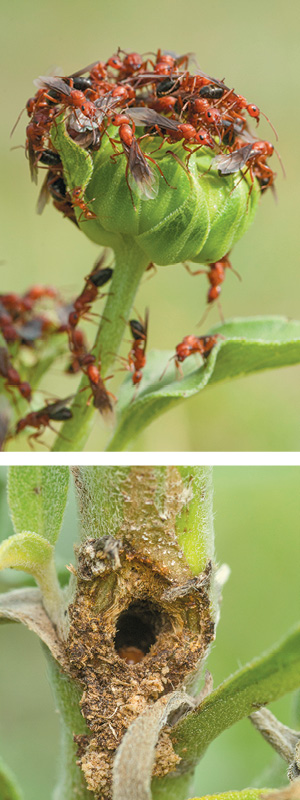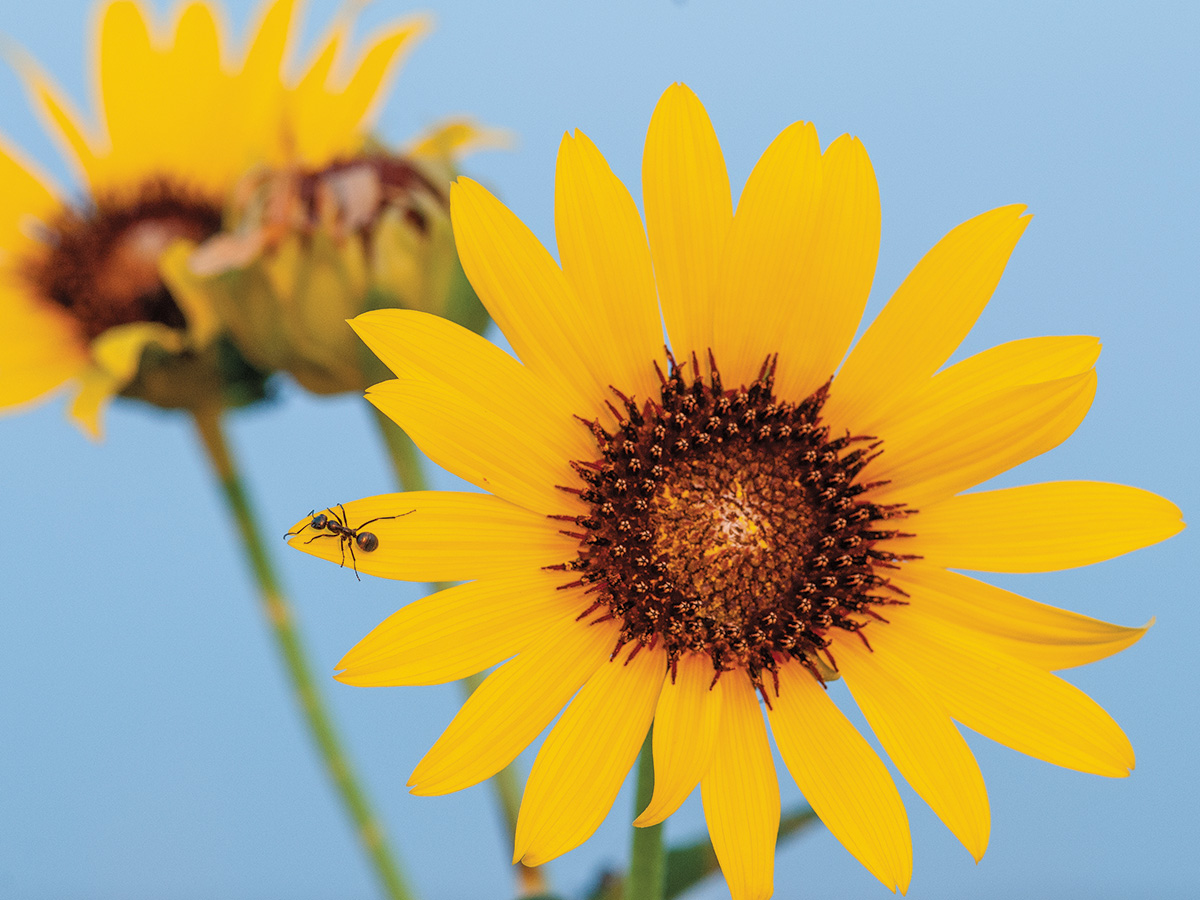Sunflower Squad Goals
The sunflower is among the most iconic of wildflowers. The distinctive shape of its inflorescence both resembles the sun and has become the default flower shape for most kindergarten artists around the country. We cultivate sunflowers (usually varieties of common sunflower, Helianthus annuus) for human food, bird food, industrial and cooking oil, and aesthetic beauty, further increasing their familiarity and popularity. There are around 70 different species of sunflowers, ranging across North and Central America, with a few extending into South America. Texas alone has about 20 native sunflower species.

The stout stems and hefty heads of sunflowers, such as this stiff sunflower (H. pauciflorus), provide both habitat and food. PHOTO Chris Helzer
The distributions of those Texas native sunflowers often overlap, which is a very good thing. The variety provided by the presence of several sunflower species in close proximity adds to the ecological resilience of a landscape. A healthy, versatile ecosystem can provide essential functions — such as food, habitat and erosion control — no matter what kinds of stresses occur, including extreme weather, disease outbreaks, fire or grazing events, and more. The presence of species with overlapping roles in an ecosystem can help build vitality because if one of those species is suppressed for a while, the others can fill in and maintain ecological function. All of this is important because sunflowers are a genus that just keeps giving.

TOP A troop of winged ants visits a prairie sunflower (H. petiolaris) to drink its extrafloral nectar. BOTTOM The larvae of some stem-boring insects eat plant tissue and then winter in sunflower stems while maturing into adults. PHOTOS Chris Helzer
Room and Board
There’s a reason we cultivate sunflowers for bird food; the seeds are large and nutritious and sought out by a multitude of avian species, along with many small mammals and invertebrates. Squirrels, in particular, often take advantage of sunflower seeds put out for birds. In addition to those nourishing kernels, sunflowers produce nectar and pollen, both of which draw a crowd.
The nectar found within each small floret in a sunflower head attracts bees, butterflies, moths, flies and other insects hungry for that sweet, nutritious liquid. The copious pollen production of sunflowers brings in some of those same species (bees, for instance, feed larvae with it), but pollen also entices grasshoppers, katydids, crickets, beetles and many others. Sunflowers seem to encourage those abundant visitors by making both their nectar and pollen easily accessible — serving it up on a literal platter.
Seeds, pollen and nectar are far from the sum total of sunflowers’ contributions to ecological communities however. The tall, robust architecture of sunflower plants provides habitat for wildlife species seeking protective cover during all seasons. That includes broods of birds such as grouse and quail looking for overhead cover for their chicks while they roam around in search of food.
Insects, too, utilize the stems and leaves of sunflower plants as habitat. Sunflower stems are commonly used by stem-boring insects, whose larvae burrow inside stalks to feed on the pith and often overwinter before emerging as adults Beetles known as silphium or head-clipping weevils (Haplorhynchites spp.) girdle the stem below a flower head, causing it to tip over and hang precariously; they then lay eggs in it. When the flower head eventually falls to the ground, larvae feed on the decaying material before eventually burrowing into the soil beneath.
Ants also find sunflowers attractive and are particularly enticed by extrafloral nectar (a saccharine substance produced by the vegetative parts of a plant). Squadrons of ants can often be seen patrolling up and down sunflowers, consuming tiny droplets of sugary liquid. As predators, those patrolling ants can provide a degree of protection from herbivorous insects in return for the sweet treats. Despite that predatory presence, however, sunflowers remain attractive to countless insect species, far beyond the few examples provided here.
Natural Survivors
Sunflowers can be found across a broad geographic range but also occur within a wide variety of habitat types. As a result, nearly any place you go in Texas will host at least one native sunflower. In fact, most sites will have several sunflower species, each with its own preference for topographic position, sun exposure and soil moisture.
For example, in East Texas, you can find the annual beach sunflower (H. debilis) on dunes and other open, disturbed areas with deep sand. The perennial hairy sunflower (H. hirsutus) can also be found on dry sites but is usually associated with open woodlands or savannas. Ashy sunflower (H. mollis) lives in mesic prairies and woodland edges, while swamp sunflower (H. angustifolius) is found in somewhat wetter soils near seeps, seasonal wetlands and openings along forested wetlands.
Having multiple sunflower species living within the same general area is important for a few reasons. The presence of more than one species means the resources sunflowers provide can be spread across a greater percentage of a landscape. A site featuring ashy sunflower and swamp sunflower, for instance, increases the total area covered by sunflowers because each uses different habitats. Differences in bloom times between multiple species of sunflowers can also stretch out the amount of time sunflower pollen, nectar and seeds are available to animals who depend upon them. During a drought, a normally abundant species of perennial sunflower might not be well adapted to dry conditions and thus fail to bloom. If other sunflower species are present that are better adapted to dry conditions, they might still manage to bloom and provide needed resources to the ecological community. In extreme circumstances, when a flood, fire or intensive grazing event creates large areas of exposed soil, annual sunflowers will often fill those spaces, germinating and growing quickly while there is limited competition from nearby plants.
The result is a temporary but critically important flush of sunflowers that helps hold soil and provide wildlife cover — while also creating a bounty of food for many animals. Within a year or two, as the rest of the plant community recovers, annual sunflowers will disappear, waiting for their next opportunity to spring up from the seed bank when they’re needed.
A diversity of sunflower species can hedge against other threats as well. For example, leaf beetles (and many other insect species) can periodically become superabundant and quickly consume all the pollen from a sunflower population, keeping pollinators from accessing that food and preventing those sunflowers from producing seed. However, the life cycle of leaf beetles is short. If there are multiple sunflower species present, with staggered bloom times, the insects are likely to be gone before the next sunflower species hits peak efflorescence, ensuring that at least some sunflower seeds will still be available in the fall.
There are countless other examples of herbivores, diseases and threats that could affect one sunflower species much more than others in a particular year. Therein lies the power of teamwork.

Prairie sunflowers like these bring joy to humans with their cheery, recognizable blooms. How often has a flower you’ve drawn looked like this? PHOTO Chris Helzer
A Hopeful Future
As our changing climate continues to alter the local growing conditions for plants, sunflowers will likely shift their locations within many landscapes. However, because most sites have more than one sunflower species, there’s a good chance that sunflowers, as a group, will still be represented at a particular site — even if they are different species in different places than we find them now.
If the climate becomes warmer and drier, sunflowers currently living on the tops of hills might find those sites too dry but manage to shift downslope into new habitats that fit their soil moisture requirements. Annual sunflowers may become more abundant in many locations as more frequent and extreme floods and droughts create increased bare ground and opportunities for those annuals to thrive. Sunflowers in the wettest portions of prairie and forest habitats, however, may find themselves without appropriate habitat, at least locally, if the overall trend is toward warmer and drier weather.
Some sunflowers may find it difficult to thrive in their current sites as the climate changes and, as a result, begin to expand their overall home ranges — especially to the north, where sites once incompatible with their growing requirements become a much better match. Relatedly, the big, nutritious seeds of sunflowers get carried around by birds and other animals (who may shell or cache them away from where they were harvested), as well as by humans, including unintentional rides in hay bales or the undercarriages of vehicles. Certain regions might experience the loss of one sunflower species because of a changing climate only to gain a new one from somewhere else.
The phenomenon of redundancy and resilience due to similar, overlapping species is not limited to sunflowers of course. Texas has more than 30 species of both milkweeds (Asclepias spp.) and prairie clovers (Dalea spp.), for example, and numerous other examples of wildflowers of extraordinary diversity within closely related species. Animal communities display that same kind of diversity, which can help ensure the persistence of important processes and functions during stressful times.
Pollinators provide a great example, with hundreds of bee, moth, butterfly, fly, and other insect species often available at any particular location to help ensure every flower is pollinated. The result of all that redundancy across plant and animal species is a series of networks that sustain the productivity and viability of natural areas and the species — including us — that rely on them.
While sunflowers are far from unique in terms of their species diversity and overlapping contributions, they are still deserving of special attention. Just the abundance of food they provide, including leaves, stems, flowers, pollen, floral nectar, extrafloral nectar and seeds, earns them prominence among wildflowers. In addition, their height and hearty architecture provides shelter for numerous animals, from tiny burrowing insects to larger vertebrates.
Finally, all of us, from artistic kindergarteners to the most cynical adult, can draw pleasure from the cheerful yellow faces of sunflowers wherever we encounter them. Fortunately, because there are so many sunflowers in so many places, it’s not hard to find opportunities for those pleasant encounters.
Chris Helzer is the Nature Conservancy’s director of science in Nebraska. He writes The Prairie Ecologist blog and is the author of “The Ecology and Management of Prairies in the Central United States.”

